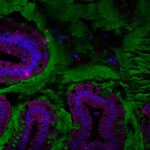Link to Pubmed [PMID] – 35758759
Link to DOI – 10.1128/aem.00734-22
Appl Environ Microbiol 2022 Jul; 88(14): e0073422
Oral antibiotic treatment is often applied in animal studies in order to allow establishment of an introduced antibiotic-resistant bacterium in the gut. Here, we compared the application of streptomycin dosed orally in microcontainers to dosage through drinking water. The selective effect on a resistant bacterial strain, as well as the effects on fecal, luminal, and mucosal microbiota composition, were investigated. Three groups of rats (n = 10 per group) were orally dosed with microcontainers daily for 3 days. One of these groups (STR-M) received streptomycin-loaded microcontainers designed for release in the distal ileum, while the other two groups (controls [CTR] and STR-W) received empty microcontainers. The STR-W group was additionally dosed with streptomycin through the drinking water. A streptomycin-resistant Escherichia coli strain was orally inoculated into all animals. Three days after inoculation, the resistant E. coli was found only in the cecum and colon of animals receiving streptomycin in microcontainers but in all intestinal compartments of animals receiving streptomycin in the drinking water. 16S rRNA amplicon sequencing revealed significant changes in the fecal microbiota of both groups of streptomycin-treated animals. Investigation of the inner colonic mucus layer by confocal laser scanning microscopy and laser capture microdissection revealed no significant effect of streptomycin treatment on the mucus-inhabiting microbiota or on E. coli encroachment into the inner mucus. Streptomycin-loaded microcontainers thus enhanced proliferation of an introduced streptomycin-resistant E. coli in the cecum and colon without affecting the small intestine environment. While improvements of the drug delivery system are needed to facilitate optimal local concentration and release of streptomycin, the application of microcontainers provides new prospects for antibiotic treatment. IMPORTANCE Delivery of antibiotics in microcontainer devices designed for release at specific sites of the gut represents a novel approach which might reduce the amount of antibiotic needed to obtain a local selective effect. We propose that the application of microcontainers may have the potential to open novel opportunities for antibiotic treatment of humans and animals with fewer side effects on nontarget bacterial populations. In the current study, we therefore elucidated the effects of streptomycin, delivered in microcontainers coated with pH-sensitive lids, on the selective effect on a resistant bacterium, as well as on the surrounding intestinal microbiota in rats.


